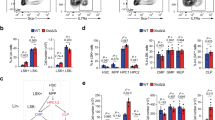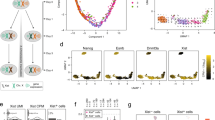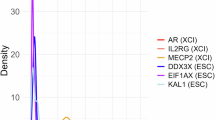Abstract
The gene dosage inequality between females with two X-chromosomes and males with one is compensated for by X-chromosome inactivation (XCI), which ensures the silencing of one X in every somatic cell of female mammals. XCI in humans results in a mosaic of two cell populations: those expressing the maternal X-chromosome and those expressing the paternal X-chromosome. We have previously shown that the degree of mosaicism (the X-inactivation pattern) in a Canadian family is directly related to disease severity in female carriers of the X-linked recessive bleeding disorder, haemophilia A. The distribution of X-inactivation patterns in this family was consistent with a genetic trait having a co-dominant mode of inheritance, suggesting that XCI choice may not be completely random. To identify genetic elements that could be responsible for biased XCI choice, a linkage analysis was undertaken using an approach tailored to accommodate the continuous nature of the X-inactivation pattern phenotype in the Canadian family. Several X-linked regions were identified, one of which overlaps with a region previously found to be linked to familial skewed XCI. SA2, a component of the cohesin complex is identified as a candidate gene that could participate in XCI through its association with CTCF.
Similar content being viewed by others
Log in or create a free account to read this content
Gain free access to this article, as well as selected content from this journal and more on nature.com
or
References
Lyon, M. F. Gene action in the X-chromosome of the mouse (Mus musculus L). Nature 190, 372–373 (1961).
Lyon, M. F. Sex chromatin and gene action in the mammalian X-chromosome. Am. J. Hum. Genet 14, 135–148 (1962).
Lyon, M. F. Lyonisation of the X chromosome. Lancet 2, 1120–1121 (1963).
Lyon, M. F. & Rastan, S. Parental source of chromosome imprinting and its relevance for X chromosome inactivation. Differentiation 26, 63–67 (1984).
Cattanach, B. M. & Isaacson, J. H. Controlling elements in the mouse X chromosome. Genetics 57, 331–346 (1967).
Cattanach, B. M. & Rasberry, C. Enhanced specific-locus mutation response of 101/H male mice to single, acute X-irradiation. Mutat. Res. 311, 77–84 (1994).
Cau, M., Addis, M., Congiu, R., Meloni, C., Cao, A., Santaniello, S. et al. A locus for familial skewed X chromosome inactivation maps to chromosome Xq25 in a family with a female manifesting Lowe syndrome. J. Hum. Genet. 51, 1030–1036 (2006).
Naumova, A. K., Plenge, R. M., Bird, L. M., Leppert, M., Morgan, K., Willard, H. F. et al. Heritability of X chromosome—nactivation phenotype in a large family. Am. J. Hum. Genet. 58, 1111–1119 (1996).
Naumova, A. K., Olien, L., Bird, L. M., Smith, M., Verner, A. E., Leppert, M. et al. Genetic mapping of X-linked loci involved in skewing of X chromosome inactivation in the human. Eur. J. Hum. Genet. 6, 552–562 (1998).
Renault, N. K., Dyack, S., Dobson, M. J., Costa, T., Lam, W. L. & Greer, W. L. Heritable skewed X-chromosome inactivation leads to haemophilia A expression in heterozygous females. Eur. J. Hum. Genet. 15, 628–637 (2007).
Allen, R. C., Zoghbi, H. Y., Moseley, A. B., Rosenblatt, H. M. & Belmont, J. W. Methylation of HpaII and HhaI sites near the polymorphic CAG repeat in the human androgen-receptor gene correlates with X chromosome inactivation. Am. J. Hum. Genet. 51, 1229–1239 (1992).
Carrel, L. & Willard, H. F. An assay for X inactivation based on differential methylation at the fragile X locus, FMR1. Am. J. Med. Genet. 64, 27–30 (1996).
Rozen, S. & Skaletsky, H. J. Primer3 on the WWW for general users and for biologist programmers. in: Krawetz S, Misener S (eds). Bioinformatics. Methods and Protocols: Methods in Molecular in Molecular Biology, Humana Press, Totowa, NJpp 365–386 (2000).
Swierczek, S. I., Agarwal, N., Nussenzveig, R. H., Rothstein, G., Wilson, A., Artz, A. et al. Hematopoiesis is not clonal in healthy elderly women. Blood 112, 3186–3193 (2008).
Cattanach, B. M., Perez, J. N. & Pollard, C. E. Controlling elements in the mouse X-chromosome II Location in the linkage map. Genet. Res 15, 183–195 (1970).
Silver, D. P., Dimitrov, S. D., Feunteun, J., Gelman, R., Drapkin, R., Lu, S. D. et al. Further evidence for BRCA1 communication with the inactive X chromosome. Cell 128, 991–1002 (2007).
Percec, I., Plenge, R. M., Nadeau, J. H., Bartolomei, M. S. & Willard, H. F. Autosomal dominant mutations affecting X inactivation choice in the mouse. Science 296, 1136–1139 (2002).
Percec, I., Thorvaldsen, J. L., Plenge, R. M., Krapp, C. J., Nadeau, J. H., Willard, H. F. et al. An N-ethyl-N-nitrosourea mutagenesis screen for epigenetic mutations in the mouse. Genetics 164, 1481–1494 (2003).
Simmler, M. C., Cattanach, B. M., Rasberry, C., Rougeulle, C. & Avner, P. Mapping the murine Xce locus with (CA)n repeats. Mamm. Genome 4, 523–530 (1993).
Bolduc, V., Chagnon, P., Provost, S., Dubé, M. P, Belisle, C., Gingras, M. et al. No evidence that skewing of X chromosome inactivation patterns is transmitted to offspring in humans. J. Clin. Invest. 118, 333–341 (2008).
Renault, N. K. E. Examining the cause and effect of skewed X-chromosome inactivation patterns in humans, PhD thesis, Dalhousie University, Halifax, (2009).
Losada, A., Yokochi, T., Kobayashi, R. & Hirano, T. Identification and characterization of SA/Scc3p subunits in the Xenopus and human cohesin complexes. J. Cell Biol. 150, 405–416 (2000).
Mannini, L., Menga, S. & Musio, A. The expanding universe of cohesin functions: a new genome stability caretaker involved in human disease and cancer. Hum. Mutat. 31, 623–630 (2010).
Michaelis, C., Ciosk, R. & Nasmyth, K. Cohesins: chromosomal proteins that prevent premature separation of sister chromatids. Cell 91, 35–45 (1997).
Wong, R. W. An update on cohesin function as a ‘molecular glue’ on chromosomes and spindles. Cell Cycle 9, 1754–1758 (2010).
Gard, S., Light, W., Xiong, B., Bose, T., McNairn, A. J., Harris, B. et al. Cohesinopathy mutations disrupt the subnuclear organization of chromatin. J. Cell Biol. 187, 455–462 (2009).
Kim, S. T., Xu, B. & Kastan, M. B. Involvement of the cohesin protein, Smc1, in Atm-dependent and independent responses to DNA damage. Genes Dev. 16, 560–570 (2002).
Yazdi, P. T., Wang, Y., Zhao, S., Patel, N., Lee, E. Y. & Qin, J. SMC1 is a downstream effector in the ATM/NBS1 branch of the human S-phase checkpoint. Genes Dev. 16, 571–582 (2002).
Dorsett, D. Cohesin, gene expression and development: lessons from Drosophila. Chromosome Res. 17, 185–200 (2009).
Kagey, M. H., Newman, J. J., Bilodeau, S., Zhan, Y., Orlando, D. A., van Berkum, N. L et al. Mediator and cohesin connect gene expression and chromatin architecture. Nature 467, 430–435 (2010).
Wendt, K. S. & Peters, J. M. How cohesin and CTCF cooperate in regulating gene expression. Chromosome Res. 17, 201–214 (2009).
Lara-Pezzi, E., Pezzi, N., Prieto, I., Barthelemy, I., Carreiro, C., Martínez, A. et al. Evidence of a transcriptional co-activator function of cohesin STAG/SA/Scc3. J. Biol. Chem. 279, 6553–6559 (2004).
Schmidt, D., Schwalie, P. C., Ross-Innes, C. S., Hurtado, A., Brown, G. D., Carroll, J. S. et al. A CTCF-independent role for cohesin in tissue-specific transcription. Genome Res. 20, 578–588 (2010).
Wendt, K. S., Yoshida, K., Itoh, T., Bando, M., Koch, B., Schirghuber, E. et al. Cohesin mediates transcriptional insulation by CCCTC-binding factor. Nature 451, 796–801 (2008).
Kang, H. & Lieberman, P. M. Cell cycle control of Kaposi's sarcoma-associated herpesvirus latency transcription by CTCF-cohesin interactions. J. Virol. 83, 6199–6210 (2009).
Degner, S. C., Wong, T. P., Jankevicius, G. & Feeney, A. J. Cutting edge: developmental stage-specific recruitment of cohesin to CTCF sites throughout immunoglobulin loci during B lymphocyte development. J. Immunol. 182, 44–48 (2009).
Wada, Y., Ohta, Y., Xu, M., Tsutsumi, S., Minami, T., Inoue, K. et al. A wave of nascent transcription on activated human genes. Proc. Natl Acad. Sci. USA 106, 18357–18361 (2009).
Skibbens, R. V., Marzillier, J. & Eastman, L. Cohesins coordinate gene transcriptions of related function within Saccharomyces cerevisiae. Cell Cycle 9, 1601–1606 (2010).
Mishiro, T., Ishihara, K., Hino, S., Tsutsumi, S., Aburatani, H., Shirahige, K. et al. Architectural roles of multiple chromatin insulators at the human apolipoprotein gene cluster. EMBO. J. 28, 1234–1245 (2009).
Horsfield, J. A., Anagnostou, S. H., Hu, J. K., Cho, K. H, Geisler, R., Lieschke, G. et al. Cohesin-dependent regulation of Runx genes. Development 134, 2639–2649 (2007).
Chao, W., Huynh, K. D., Spencer, R. J., Davidow, L. S. & Lee, J. T. CTCF, a candidate trans-acting factor for X-inactivation choice. Science 295, 345–347 (2002).
Donohoe, M. E., Zhang, L. F., Xu, N., Shi, Y. & Lee, J. T. Identification of a Ctcf cofactor, Yy1, for the X chromosome binary switch. Mol. Cell 25, 43–56 (2007).
Navarro, P., Page, D. R., Avner, P. & Rougeulle, C. Tsix-mediated epigenetic switch of a CTCF-flanked region of the Xist promoter determines the Xist transcription program. Genes Dev. 20, 2787–2792 (2006).
Parelho, V., Hadjur, S., Spivakov, M., Leleu, M., Sauer, S., Gregson, H. C. et al. Cohesins functionally associate with CTCF on mammalian chromosome arms. Cell 132, 422–433 (2008).
Boumil, R. M., Ogawa, Y., Sun, B. K., Huynh, K. D. & Lee, J. T. Differential methylation of Xite and CTCF sites in Tsix mirrors the pattern of X-inactivation choice in mice. Mol. Cell Biol. 26, 2109–2117 (2006).
Pugacheva, E. M., Tiwari, V. K., Abdullaev, Z., Vostrov, A. A, Flanagan, P. T, Quitschke, W. W et al. Familial cases of point mutations in the XIST promoter reveal a correlation between CTCF binding and pre-emptive choices of X chromosome inactivation. Hum. Mol. Genet. 14, 953–965 (2005).
Plenge, R. M., Hendrich, B. D., Schwartz, C., Arena, J. F, Naumova, A., Sapienza, C. et al. A promoter mutation in the XIST gene in two unrelated families with skewed X-chromosome inactivation. Nat. Genet. 17, 353–356 (1997).
Bacher, C. P., Guggiari, M., Brors, B., Augui, S., Clerc, P., Avner, P. et al. Transient colocalization of X-inactivation centres accompanies the initiation of X inactivation. Nat. Cell Biol. 8, 293–299 (2006).
Xu, N., Donohoe, M. E., Silva, S. S. & Lee, J. T. Evidence that homologous X-chromosome pairing requires transcription and Ctcf protein. Nat. Genet. 39, 1390–1396 (2007).
Navarro, P. & Avner, P. An embryonic story: analysis of the gene regulative network controlling Xist expression in mouse embryonic stem cells. Bioessays 32, 581–588 (2010).
Gause, M., Misulovin, Z., Bilyeu, A. & Dorsett, D. Dosage-sensitive regulation of cohesin chromosome binding and dynamics by Nipped-B, Pds5 and Wapl. Mol. Cell Biol. 30, 4940–4951 (2010).
Rollins, R. A., Korom, M., Aulner, N., Martens, A. & Dorsett, D. Drosophila nipped-B protein supports sister chromatid cohesion and opposes the stromalin/Scc3 cohesion factor to facilitate long-range activation of the cut gene. Mol. Cell Biol. 24, 3100–3111 (2004).
Jonkers, I., Barakat, T. S., Achame, E. M., Monkhorst, K., Kenter, A., Rentmeester, E. et al. RNF12 is an X-Encoded dose-dependent activator of X chromosome inactivation. Cell 139, 999–1011 (2009).
Acknowledgements
We thank Drs M Dobson, C Riddell, P Avner and S Dyack for helpful discussions. We gratefully acknowledge the CIHR, Killam Trust, Canadian Hemophilia Society, CDHA, IWK Health Centre, and Dalhousie University for support. Part of this work was completed by the Australian Genome Research Facility, Victoria, Australia. We acknowledge their contribution and the support they receive from the Commonwealth.
Author information
Authors and Affiliations
Corresponding author
Ethics declarations
Competing interests
The authors declare no conflict of interest.
Additional information
Supplementary Information accompanies the paper on Journal of Human Genetics website
Rights and permissions
About this article
Cite this article
Renault, N., Renault, M., Copeland, E. et al. Familial skewed X-chromosome inactivation linked to a component of the cohesin complex, SA2. J Hum Genet 56, 390–397 (2011). https://doi.org/10.1038/jhg.2011.25
Received:
Revised:
Accepted:
Published:
Issue date:
DOI: https://doi.org/10.1038/jhg.2011.25
Keywords
This article is cited by
-
Cohesin complexes with a potential to link mammalian meiosis to cancer
Cell Regeneration (2013)
-
Human X-chromosome inactivation pattern distributions fit a model of genetically influenced choice better than models of completely random choice
European Journal of Human Genetics (2013)



